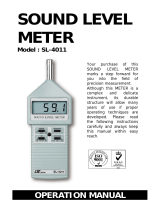4 SDL600-en-GB_V1.6 12/17
Frequency Weighting ‘A’ and ‘C’
Select ‘A’ or ‘C’ frequency weighting in the SETUP Mode. With ‘A’ weighting selected, the frequency
response of the meter is similar to the response of the human ear. ‘A’ weighting is commonly used
for environmental or hearing conservation programs such as OSHA regulatory testing and noise
ordinance law enforcement. ‘C’ weighting is a much flatter response and is suitable for the sound
level analysis of machines, engines, etc. Most noise measurements are performed using 'A'
Weighting and SLOW Response.
Response Time ‘FAST’ and ‘SLOW’
Press and hold the FUNCTION button until the desired response time (FAST or SLOW) is shown.
Select FAST to capture noise peaks and noises that occur very quickly. Select the SLOW response
to monitor a sound source that has a consistent noise level or to average quickly changing levels.
Select SLOW response for most applications.
Display Backlight
To turn the display backlight ON or OFF, press and hold the backlight button for at least 1.5
seconds.
Data Hold
To freeze a displayed reading on the LCD, momentarily press the HOLD button (the HOLD display
icon will appear). To release the held reading, press the HOLD button again.
Peak Hold
To capture and freeze a noise peak, press and hold the FUNCTION button until the PEAK icon is
displayed on upper left-hand corner of the LCD. In this mode, the displayed reading will only change
when a higher sound peak is captured. To exit this mode, press and hold the FUNCTION button
until the PEAK icon switches off.
Max-Min Reading Record and Recall
For a given measurement session, this meter can record the highest (MAX) and the lowest (MIN)
readings for later recall.
1. Press the MAX-MIN button momentarily to access this mode of operation (REC icon appears)
the meter is now recording the MAX and MIN readings.
2. Press the MAX-MIN button again to view the current MAX reading (MAX icon appears). The
reading on the display is now the highest reading encountered since the REC icon was switched
on (when the MAX-MIN button was first pressed).
3. Press the MAX-MIN button again to view the current MIN reading (MIN icon appears). The
reading on the display is now the lowest reading encountered since the REC icon was switched
on (when the MAX-MIN button was first pressed).
4. To exit the MAX-MIN mode, press and hold the MAX-MIN button for at least 1.5 seconds. The
meter will beep, the REC-MAX-MIN icons will switch off, the MAX-MIN memory will clear, and
the meter will return to the normal operating mode.












